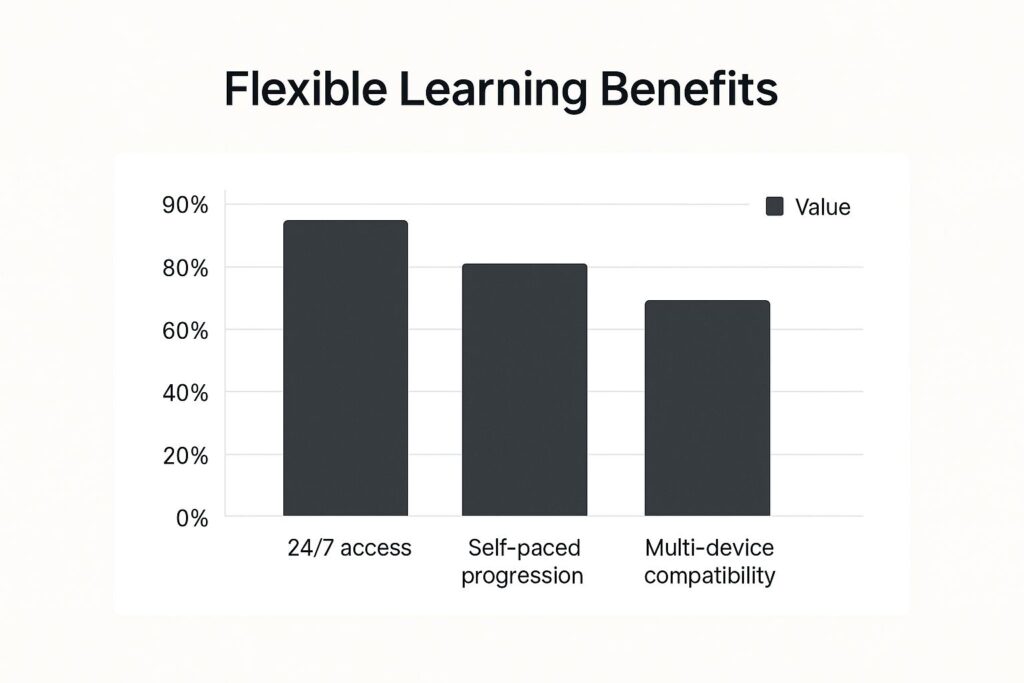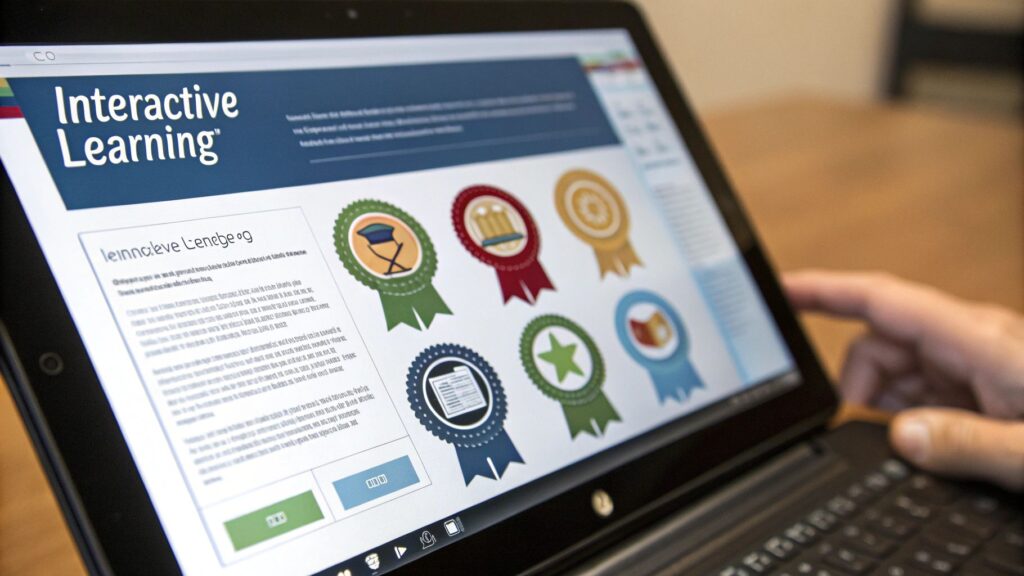8 Key Benefits of eLearning for Course Creators in 2025

If you’re an expert, entrepreneur, or educator, you’ve probably considered creating an online course or a membership site. It’s a fantastic way to share what you know and build a business around your passion.
But where do you even start? For people like us, the answer has become increasingly clear: elearning.
Elearning isn’t just a trend anymore. It has become the foundation of modern education and a core part of many digital businesses. It has completely changed how we learn and, more importantly, how we teach. It’s about a lot more than just uploading a few videos.
I think it’s a powerful framework for creating flexible, engaging, and scalable learning experiences that just weren’t possible a decade ago.
The benefits of elearning are a game-changer for creators. They allow us to build thriving communities and successful, sustainable businesses.
Let’s explore exactly how each benefit works, with practical examples and steps you can take right away.
1. Flexible Learning and Self-Paced Education
One of the biggest benefits of elearning is how flexible it is. Traditional education often forces learners into a rigid schedule, but elearning breaks down those walls. It gives people the power to access course content anytime, anywhere, and on any device that works for them.
This self-paced model is a huge deal for all kinds of people. Think of working professionals balancing a full-time job, parents managing family commitments, or students in different time zones.
For them, being able to learn during a lunch break, late at night, or on the weekend is more than just a convenience, it’s a necessity. Platforms like Coursera and Khan Academy built their empires on this very idea, offering world-class education that fits into people’s real lives.
How to Maximize Flexibility for Your Learners
To make the most of this benefit, you need to design your courses with flexibility in mind. Things like:
- Set Clear Milestones: Give learners a suggested timeline with key milestones. This provides a path to follow without imposing strict deadlines, which helps them stay on track.
- Encourage Accountability: You can promote the formation of online study groups or peer accountability partners. This social side of things helps learners stay motivated and engaged.
- Leverage Technology: Remind learners to use calendar apps and reminders to schedule their study sessions. They should treat them like any other important appointment.

When you’re deciding between different course delivery models, it’s really important to understand what your audience wants.
To dive deeper into this, you can learn more about the differences between instructor-led and self-paced learning to find the right fit for your audience.
2. Cost-Effectiveness and Budget Efficiency
Beyond flexibility, one of the most compelling benefits of elearning is its big impact on your budget.
Traditional, in-person training comes with a long list of expenses: venue rentals, instructor travel, printed materials, and even catering.
Elearning gets rid of or drastically reduces these costs, making high-quality education more accessible and financially sustainable.

Think of major corporations that have used this to their advantage. IBM famously reported saving around $200 million annually after shifting a lot of its training online.
Accenture also saved an estimated $3 million in travel costs by using virtual learning programs.
How to Maximize Budget Efficiency
To get the full financial benefit of elearning, you need a smart approach to planning and execution.
- Calculate True ROI: When you’re measuring return on investment, look beyond just direct cost savings. You should also factor in the value of saved employee time, reduced downtime, and productivity gains from upskilled team members.
- Invest in Reusable Content: Focus on creating high-quality, evergreen content that can be reused across multiple groups or updated easily. This “create once, use many times” approach is a key part of elearning’s cost-effectiveness.
- Choose Scalable Platforms: Pick a learning management system (LMS) or course platform that can grow with your audience without huge cost increases. A scalable foundation keeps you from having to migrate systems later on.
The initial investment in creating an online course can feel like a lot, but the long-term savings and scalability make it a financially smart strategy. Understanding the upfront expenses is the first step toward building a profitable educational program.
If you’re planning your budget, you can learn more about how much it costs to create an online course to get a clearer picture of the investment required.
3. Personalized Experience and Adaptive Content
Beyond just flexibility, one of the most powerful benefits of elearning is its ability to deliver a truly personalized experience.
Unlike a one-size-fits-all classroom lecture, digital platforms can use data and AI to tailor educational content to an individual’s specific needs, strengths, and weaknesses. This creates a learning path that adjusts in real time.
This customization is a game-changer for effective education. If a learner is struggling with a concept, the system can provide more basic materials or different explanations. If they master a topic quickly, it can move them on to more advanced content.
Platforms pioneered by people like Jose Ferreira of Knewton have shown how this adaptive tech can find and fill knowledge gaps with amazing precision. This makes sure learners build a solid foundation before moving on. It changes learning from a passive broadcast into an active, responsive conversation.
How to Maximize Personalization for Your Learners
To use the power of adaptive content, you need to build your course with individual paths in mind.
- Implement Diagnostic Assessments: Start with a good initial assessment. This gives your system the baseline data it needs to start building a unique learning profile for each student.
- Offer Diverse Content Formats: Provide the same core information in multiple formats, like video, text, interactive simulations, and quizzes. This lets the system serve content in the format a learner prefers or finds most effective.
- Encourage Active Feedback: Add simple feedback tools where learners can rate how useful the content is. This direct input helps the adaptive engine make better recommendations and improve the experience for everyone.
Personalization makes learning more engaging and effective. When learners feel the content is directly relevant to their needs, their motivation and retention shoot up.
To put this into practice, think about tools like Carnegie Learning’s MATHia, which uses an adaptive engine to provide a personal math coach for every student. This approach makes sure you are meeting learners exactly where they are.
4. Global Accessibility and Inclusive Education
One of the most profound benefits of elearning is its power to make education more democratic. It tears down geographical, physical, and socioeconomic barriers.
It provides universal access to learning resources, letting people from remote areas, those with disabilities, or learners from different economic backgrounds access the same high-quality content as anyone else. This creates a more fair and inclusive educational world.

This global reach isn’t just a theory, it’s a reality powered by platforms dedicated to open access. For instance, edX, co-founded by Anant Agarwal, has reached over 40 million learners across 196 countries.
Similarly, projects like MIT OpenCourseWare provide free, unrestricted access to university-level course materials. This gives anyone with an internet connection the power to learn from one of the world’s top institutions.
In another example, BYJU’S has successfully delivered quality education to students in rural India, proving that elearning can bridge the urban-rural divide.
How to Maximize Accessibility and Inclusivity
To truly embrace this benefit, you must intentionally design your courses to be accessible to the widest possible audience.
- Design for Low Bandwidth: Not everyone has a high-speed internet connection. You should optimize your videos, use lower-resolution images, and provide text-based alternatives to make sure your content is accessible in low-bandwidth areas.
- Prioritize Accessibility Features: Build your course with accessibility in mind from the very beginning. This includes adding closed captions to videos, providing transcripts for audio content, using high-contrast colors, and making sure your platform is navigable with a screen reader.
- Be Culturally Conscious: Use examples, images, and language that are culturally sensitive and inclusive. If possible, providing course materials or subtitles in multiple languages can dramatically expand your reach and make learners feel more welcome.
This approach makes sure you are building an inclusive learning environment. By focusing on global accessibility, you tap into a much larger audience and contribute to a more educated and connected world. It’s a powerful way to make a real impact beyond just your immediate community.
5. Enhanced Engagement Through Interactive and Multimedia Content
One of the most powerful benefits of elearning is its ability to turn passive content consumption into an active, engaging experience.
Unlike static textbooks, digital platforms can weave in interactive elements, rich multimedia, and even game-like mechanics. This approach captures learner attention, making the material more memorable and motivating.
This active learning model is critical for improving knowledge retention and overall course satisfaction. Think about learning a new language through a gamified app like Duolingo, where points and streaks keep you coming back.
Or consider Codecademy, where learners write real code and get instant feedback. These platforms, pioneered by visionaries like Luis von Ahn and Zach Sims, prove that interactive content is a better way to learn.

How to Maximize Engagement for Your Learners
To make your courses truly engaging, you need to be intentional about adding interactive and multimedia content.
- Pace Your Interactivity: Keep learners on their toes by including an interactive element like a quiz, a drag-and-drop activity, or a short video every 10 to 15 minutes. This breaks up the monotony and reinforces key concepts.
- Use Multimedia with Purpose: Videos, infographics, and audio clips should support your learning objectives, not just decorate the page. Use them to explain complex ideas, show real-world examples, or provide different perspectives.
- Balance Gamification: While leaderboards and badges can be highly motivating, make sure they don’t overshadow the core educational goals. The focus should always be on learning, with gamification acting as a supportive element.
- Test Everything: Interactive elements can act differently across various devices and browsers. You should always test your quizzes, simulations, and videos to guarantee a smooth and frustration-free experience for everyone.
A stunning 93% of learners report that they prefer gamified, interactive training over traditional methods.
When you build your course, remember that engagement is a direct result of active participation. To explore this further, you can learn more about using gamification in your elearning courses to see how you can apply these principles effectively.
6. Real-Time Progress Tracking and Data-Driven Analytics
One of the most powerful benefits of elearning is the ability to see exactly what’s working and what isn’t, in real time.
Unlike traditional learning where assessment is often delayed, digital platforms offer a continuous stream of data. This allows both instructors and learners to monitor progress, pinpoint challenges, and make informed decisions on the fly.
This data-driven approach turns education from a one-size-fits-all lecture into a personalized, responsive experience. For instance, an instructor using Canvas or Blackboard can immediately see which students are struggling with a specific quiz question and provide targeted support.
Similarly, platforms like LinkedIn Learning use analytics to suggest new skills based on a user’s progress and career path. This detailed insight, championed by pioneers like John Baker of D2L Brightspace, helps ensure no learner gets left behind.
How to Maximize Data-Driven Analytics for Your Learners
To effectively use analytics, you have to go beyond just collecting data and start using it to drive improvement.
- Establish Clear Learning Objectives: Before you track anything, define what success looks like. Set specific, measurable learning objectives for each module so you can track progress against meaningful goals, not just completion rates.
- Review Data Regularly: Schedule time to review learner analytics. Look for patterns, such as common drop-off points in a video or frequently failed quiz questions. This helps you find content that needs to be revised or clarified.
- Empower Learners with Their Data: Share progress reports directly with learners. Visualizing their own journey, including completed modules and skill improvements, can be a huge motivator. It also helps them take ownership of their education.
Key Insight: Data analytics is a proactive tool. It enables continuous improvement for your courses and personalized guidance for your students, creating a more effective and supportive learning environment.
This focus on evidence-based decision making is a cornerstone of modern education. By analyzing learner interactions, you can refine your teaching strategies, enhance course materials, and ultimately deliver better outcomes.
To get the most out of your platform, it’s essential to explore all the features of your chosen Learning Management System (LMS) and understand how its analytics can support your educational goals.
7. Scalability and Consistency in Content Delivery
Another one of the most powerful benefits of elearning is its ability to deliver standardized training to a massive audience all at once. Traditional, in-person training hits a wall when you need to teach thousands of people across different locations.
Elearning completely removes that wall, allowing you to train everyone from a single, centralized platform.
This ensures every single learner, whether they’re in Topeka or Tokyo, gets the exact same high-quality instruction.
Think about global giants like McDonald’s, which uses its online Hamburger University to train millions of employees worldwide with perfect consistency.
Similarly, platforms like Salesforce Trailhead and Microsoft Learn, championed by leaders like Marc Benioff and Satya Nadella, deliver uniform, up-to-date technical training to millions of developers and professionals. This ensures everyone is on the same page.
This level of consistency is just impossible to achieve with face-to-face instruction alone.
How to Ensure Your Content Scales Effectively
To use this benefit, you need a strategy that supports growth and maintains quality across the board.
- Design with a Global Mindset: Create content that is culturally neutral and easy to translate. Avoid regional slang, culturally specific examples, or imagery that might not resonate with a global audience. This makes your content universally accessible.
- Invest in Robust Infrastructure: Your learning platform must be able to handle high traffic, especially during peak usage times. Work with a reliable hosting provider or learning management system (LMS) that guarantees uptime and can manage a large number of concurrent users without a hitch.
- Standardize Your Assessments: Develop clear, objective assessment criteria and rubrics. This ensures that every learner is evaluated using the same standards. It makes your certifications and qualifications meaningful and consistent no matter where the learner is located.
8. Environmental Sustainability and Reduced Carbon

Beyond learner-focused advantages, one of the most compelling benefits of elearning is its positive impact on the environment.
Traditional education models require significant resources, from daily commutes and heated classrooms to mountains of printed textbooks. Elearning drastically reduces this environmental footprint by digitizing the entire educational experience.
This digital-first approach lines up perfectly with modern sustainability goals. When learners access materials from home, they eliminate carbon emissions from travel.
By replacing physical handouts with downloadable PDFs and interactive modules, you cut down on paper waste and the energy needed for printing and distribution. Major institutions have measured this impact.
A landmark study by The Open University revealed its distance learning courses generate 87% lower CO2 emissions per student compared to campus-based alternatives.
How to Maximize Sustainability for Your Program
To fully use this eco-friendly benefit, you can build sustainability directly into your course delivery strategy.
- Choose Green Hosting: Select a web hosting provider that is committed to sustainability and uses renewable energy sources to power its data centers.
- Optimize Content Delivery: Compress videos and images to reduce their file size. This lowers the amount of data that needs to be transferred, which in turn reduces energy consumption for both your servers and your learners’ devices.
- Track and Report Your Impact: Use simple calculations to estimate the environmental savings your program generates. You can track metrics like avoided travel miles or saved paper and share these positive results with your community. This reinforces the value of your digital-first approach.
Putting It All Together
So there you have it. We’ve walked through some of the biggest game-changers that elearning brings to the table for creators like us. From giving your students the freedom to learn on their own terms to reaching a global audience you never thought possible, the opportunities are massive.
It’s clear that the benefits of elearning go way beyond just convenience. They represent a huge shift in how we can build, scale, and manage educational content.
The journey from a course idea to a thriving online learning community is built on understanding and using these advantages. Each benefit we explored is a tool in your creator toolkit. Mastering them lets you deliver an educational product that is effective and really connects with your learners’ needs.
The world of online education is the new standard for accessible, effective, and engaging learning.
By thoughtfully applying these principles, you position yourself as a leader in your niche. You build a more sustainable business, a more connected community, and a more impactful educational legacy.
The tools are here. The opportunity is now. Go build something amazing.






